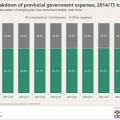Education
Quick Fact
Among children aged 17 years and lower who were living with a disability, close to 89% were attending school in 2019. The highest percentage of children with disability not attending school were found in Northern Cape (16,7%) followed by Eastern Cape (15,3%) and Western Cape (14,3%).

In South Africa, education is governed by two national departments, namely the department of Basic Education (DBE), which is responsible for primary and secondary schools, and the department of Higher Education and Training (DHET), which is responsible for tertiary education and vocational training.
Government regularly collects and releases education statistics to monitor and manage the education system. The statistics are primarily published by the Department of Basic Education, the Department of Higher Education and Statistics South Africa. Statistics South Africa undertakes periodically national censuses and household surveys to collect information on demographic and socio-economic characteristics of the population as well as living arrangements and access to amenities by households.
Education and Society
Education information published by Statistics South Africa is mostly based on the annual General Household Surveys; the inter-censal Community Surveys and the decennial Censuses are also used to generate education statistics. These include data on education which consist of attendance of educational institutions, educational attainment, fields of study as well as literacy levels among the population. Household surveys data are important as they enable analysis of education information by households and individual population characteristics. Such data complement school and institution based data produced by the Departments of Basic and Higher Education as they provide household members background information that may influence schooling decisions. Questions used in these surveys are kept consistent to allow the use of multiple censuses and surveys for comparison over time.
Thematic reports produced from these surveys contain information on a variety of subjects in the field of education statistics. For example, the education series iii report which draws from these sources, includes information on educational attainment, literacy, average years of education received by school phases, enrolments, mode of transport used to get to educational institutions and intergenerational educational mobility. Factors that influence educational outcomes, education characteristics of the youth in comparison to their parents, and the relationship between educational outcomes of parents and their children are also provided.
The average change in the prices of tuition fees for both secondary and higher education are covered by the Consumer Price Index (CPI) release.
Financial Health of Higher Education Institutions
National Accounts and Government Finances. This statistical release provides economic and practical categorisations of financial transactions of higher education institutions for each financial year. Higher education institutions refers to any institution that provides higher education on a full-time, part-time or distance basis. Government finance statistics are used to (i) analyse and evaluate the outcomes of fiscal policy decisions, (ii) determine the impact on the economy, and (iii) compare national and international outcomes.
Educational Indicators
Tertiary Education Fees

Exploring the provincial government wage bill
Provincial government provides a wide range of essential services, from education and health to infrastructure development. Recent data show how much money provincial government spends, in particular on compensation of employees. Government expenditure can be classified in functional and economic terms. The functional view reflects the purpose for which transactions are undertaken, mainly in terms read more »

